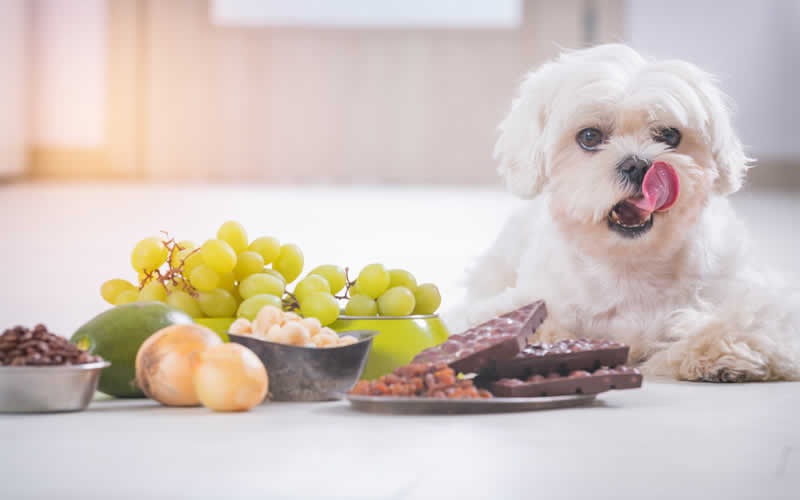
The majority of foods we eat and feed to our pet (especially plant-based) are healthy and good for them, but these are the few exceptions to be aware of –
Grapes, Raisins, Sultanas and Currants
How dangerous are grapes and raisins to dogs?
It only takes a very small amount of grapes, raisins, sultanas or currants to cause severe issues in some dogs and can even result in death. There is no correlation between the amount of fruit eaten and the size of dog and research has not yet revealed which part of the grape or raisin is toxic to our dogs. Vitis Vinifera is the chemical found within grapes and raisins that can cause serious damage to their kidneys.
Whilst one dog may have eaten a handful and been fine, it may only take eating a single raisin to prove fatal in another dog. For this reason, it’s not advisable to feed any grapes, raisins, sultanas or currants to your dog. Be aware of any products such as fruitcakes, muffins or mince pies containing these fruits and to store foods containing these ingredients well out of reach of your dog.
If you’re baking at home with these potentially toxic ingredients be extra careful and do not leave children alone with your dogs in the kitchen or the food cupboard within reach of your potentially greedy dog.
Chocolate
Chocolate and cocoa products are poisonous to dogs and in large enough amounts can sadly be fatal. The toxic component of chocolate is theobromine as chocolate comes from the Theobroma cacao tree.
We can easily metabolise theobromine but it is not the same for our dogs. They metabolise theobromine much more slowly, causing it to build up to toxic levels in their system.
How much chocolate is poisonous to a dog?
The level of toxicity of chocolate to your dog depends on the type of chocolate e.g white, milk, dark chocolate, the amount consumed and your dog’s size. In general a larger dog could consume more chocolate than a small dog before suffering ill effects. Cocoa powder is particularly concentrated and if your dog has licked it, book an emergency visit with your vet.
What are the symptoms if my dog eats chocolate or licks cocoa powder?
Initially, chocolate poisoning will usually present with severe hyperactivity.
So if you suspect your dog has eaten chocolate and they are hyperactive, panting excessively and unable to settle please call your vet. In extreme cases large amounts of theobromine can produce muscle tremors, seizures, an irregular heartbeats, internal bleeding, organ damage or a heart attack.
Onions, Chives and Leeks
Onions, chives and leeks (Allium species):
We all love to cook with onion for ourselves (especially being plant-based), but when onions are ingested in sufficient amounts by our pets the chemicals in these foods have the ability to destroy their red blood cells causing severe anaemia.
Eating onions of more than 0.5% of your dog’s body weight are potentially toxic. Cats and some Japanese breeds of dog such as the Akita are more sensitive to the toxic effects than most. Symptoms are generally secondary to the anaemia and include weakness, lethargy and pale coloured gums.
Signs and Symptoms:
Your dog may have an onion smell on its breath, be lethargic, have pale gums (due to the anaemia), and pant excessively. Book an appointment with your vet if you notice and smell these signs and stop your dog from eating these foods.
Macadamia Nuts
As shown in our research into the healthiest plant based diet for our dogs, not all nuts cause problems in our dogs but it is helpful to know that Macadamia nuts are toxic to our dogs.
Depending on the amount of nuts ingested, symptoms of severe lethargy, increased body temperature, vomitting, tremors, joint stiffness, and inability to walk (due hind limb weakness) may be seen. The toxic mechanism is unknown but it can affect nerve and muscle function.
Some dogs may also develop pancreatitis (inflammation of the pancreas) due to the high fat content of these nuts.
Potato skin
Always peel potatoes before cooking and feeding to your dog. The potato skin contains high levels of solanine that is toxic to our pets, so always just peel those potatoes
Xylitol
Xylitol is an artificial sweetener (not great for us either as humans!) It is often found in sweets, chewing gums, some peanut butters and even toothpastes.
It is important to keep these products out of reach of your dogs or buy natural products with no additives – especially peanut butter. Xylitol is poisonous to dogs. Levels of toxicity are potentially mild to severe but depend on the amount ingested.
It is important to be aware that signs of Xylitol poisoning vary and can present rapidly or be delayed.
Common signs to watch out for are:
- Weakness
- Lethargy
- Collapse
- Vomitting
- Tremors
- Seizures
- Jaundice (yellow skin or eyes)
There is the story of prisoners in a UK jail who had their friends bring in large quantities of chewing gum with Xylitol in it which they fed to the guard dogs and caused some deaths!
What about Avocado, Walnuts, Pine Nuts, Almonds and Popcorn?
Find out about whether these ingredients and more are safe for your dog in our very informative PLANT-BASED DOG NUTRITION COURSE


